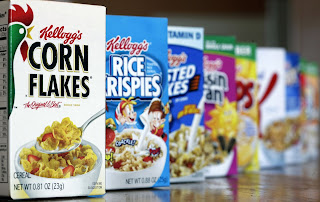KELLOGG's ENTRY IN INDIA- Importance of appropriate Positioning
“Mothers
know what they want and when, we can’t push our offering to them without giving
them a reason they value”, this
was clarified by the head of marketing team at kellogg’s. Kellogg’s had a very
hard time in the beginning when they entered the Indian market, back in 1994, due
to inappropriate ‘POSITIONING’ strategy.
When
kellogg’s entered the Indian market, they tried to change the trend of Indian
breakfast from hot cooked regional items to ready-to-eat meals (his number one
brand, corn flakes), which was not a part of their (Indian) cultural norm.
breakfast habits in India, for the most part, included items like flattened
rice flakes (poha) in central and western India, whole wheat grits (dhalia)
and parathas in northern part and idli or dosa in south. So trying to
change this traditional regional staples was a cumbersome task.
Nevertheless
they still tried to market their product, but this time they tried to
communicate to consumers that Indian breakfast options were not as healthy as
corn flakes and particularly emphasized on the nutritional benefits and
crispiness of its cereals. They even reinforced the positioning with a tagline-
“jaago jaise bhi, lo kellogg’s hi” (“ No matter how you start your day, start
it with kellogg’s). But average Indian did not pay attention to iron/vitamin
intake at that time. Initially there was an impressive sales but the fact was
that this was a result of one-off purchases, and kellogg’s knew that very well.
There were few repeat purchases as the initial excitement wore off. Another
barrier in sales was the high prices, this was almost 30 % costlier than its
nearest competitor and Indians did not find value in spending for an expensive
breakfast.
Repositioning
and product extensions: When kellogg’s realized that it was very difficult to
target Indian market, they came up with 2 new products, Chocos and Frosties in
1996 and 1997 respectively, hence moving their target towards kids. They now
positioned these items as mid-meal snacks to fulfil nutrition rather than
breakfast meal. Finally targeting kids helped kellogg’s to gain a valuable
postion in the market. In 1999, they positioned conflakes as “Iron Shakti”
cornflakes and addressed iron deficiency in children. Kellogg’s was the only
company at that time that spoke about iron supplement and this became a
differentiator and sales increased drastically by 17%. Further other than positioning changes they
even removed the rooster from all the advertisements India. In 1997, the
company even launched the “Kellogg’s breakfast week”, a community-oriented
initiative to create awareness about prevention of anemia (an iron deficiency
disorder). Their research suggested that even though they positioned to kids
but it was eventually consumed by the whole family due to awareness about
living a nutritive and healthier life.
The
launch of Special K: In 2008, the company launched their $ 1.5 billion weight
management cereal “Special K” that targeted women (aged 25-44 years) who wanted
to keep in shape. It was positioned as weight control meal and was a player in
Rs 500-crore weight management market. So coming to an end, it was found in a
research that incorrect positioning was the “key reason” behind 80% brand
failures.

Comments
Post a Comment